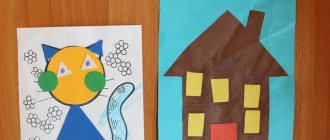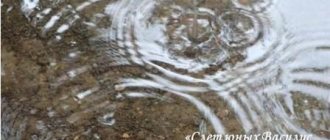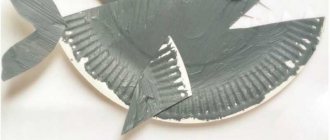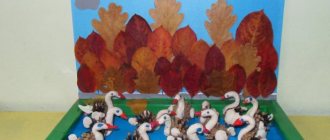Ecological fairy tale for children 5-7 years old
“The Tale of How the Golden Fish Saved the Sea” An environmental fairy tale for children aged 5-7 years.
Goal: developing an idea of the patterns in nature, that a violation of natural patterns can lead to an environmental disaster. Objectives: — carrying out preventive work to prevent pollution of water bodies; — expanding the horizons of pupils; development of oral speech; - fostering a love of nature; compassion for all living things. “The Tale of How the Golden Fish Saved the Sea” (The publication uses illustrations by I. Yesaulov)
In the underwater Kingdom of the Blue-Green State, there lived a Golden Fish.
She was very cheerful, such an entertainer that it’s hard to imagine! Either she decides to play with a ray of sunshine, or she decides to make multi-colored pyramids out of sea pebbles... I’m never bored. And the Golden Fish had friends - Medusa, Crab and Turtle. They all loved their home – the sea. After all, at the bottom of the sea they had so many interesting things: pink and bright red corals grew everywhere, as if outlandish trees, mother-of-pearl shells lay here and there, preserving their beautiful pearls. Once a year, all the shells opened their doors and showed the underwater world their wealth - pearls, and after that, having heard enough of the enthusiastic exclamations of the audience, the shells again hid the pearls in their mother-of-pearl chests for the whole year. But one morning a big disaster happened to the inhabitants of the Underwater Kingdom. The sea inhabitants were enjoying a beautiful summer morning, when a huge shadow lay on the bottom of the sea. Medusa : -What is it? What's happened?
Crab: -This is an oil tanker floating above us.
Turtle: -Oh, Crab, how smart you are! What is a tanker? And why is it called “oil”?
Crab: -And this is a ship that transports oil from one place to another. Medusa: -Oh, here it is... Well, what is it that flows out of it and spreads like a black spot, blocking the sky and the sun from us? Crab: -Oh, what a horror, but this is a leak on the ship, that is, a hole has formed somewhere - a hole from which oil is leaking. Soon we will all die! Turtle: -Don’t joke like that, Crab!.. Crab: -I’m not joking, oil is very oily, it will cover the surface of the water with a greasy film and air will stop flowing into our water. And we will all suffocate! Medusa: -What? What do we do? Crab: -I don’t know... Turtle: -But I know! On the other side of the sea there is a Pink Shell. It contains magical bacteria - tiny creatures that can eat an oil slick. This is a real treat for them! And here's another thing - today is the day when all the sea shells open their doors! Goldfish: -I’ll immediately swim for the Pink Shell, because I swim faster than all of you! And we will save our home - the sea! And the brave Golden Fish set off on a journey, with great difficulty she found that very treasured Pink Shell and brought it home! The unfortunate friends were already barely alive... They gasped for air with their tiny mouths and felt completely bad. The pink pearl released bacteria into the water and they quickly dealt with the nasty oil slick! The sun shone again, and even the clouds in the blue sky became visible to the inhabitants of the underwater Kingdom! Everyone breathed freely! And the Golden Fish was the most happy, because she helped save her such a beautiful and beloved underwater world from destruction!
After reading the fairy tale, you can ask questions:
- Why did the sea inhabitants almost die? — How did the sad events of the fairy tale make you feel? — Name the rules of behavior on reservoirs.
We recommend watching:
Ecological conversation for children of the preparatory group Ecology quiz game “Nature Experts” for children of the senior group Environmental event in the senior group. Scenario Summary of an experiment on ecology in kindergarten. Senior group
Similar articles:
Lesson summary on the topic “Reserve” in the senior group
Summary of a lesson on ecology in the senior group on the topic: Sea inhabitants
Lesson notes on ecology in the senior group of kindergarten
Conversation “Take care of the forest” for preschool children of the senior preparatory group
Lesson summary - fairy tales in the preparatory group of kindergarten
Tales about fish
Everyone loves fish. Both adults and children. What could be more mysterious and wonderful than the ocean depths? “The Tale of the Goldfish” and “At the Command of the Pike” were written for children. Pisces in these and many similar works fulfill the wishes of the person who left them life and freedom. Adults will enjoy Saltykov-Shchedrin's ironic tales about crucian carp, ruffe and minnows, whose behavior is a caricature of human vices in society. There are also legends and tales about fish and monsters among different peoples, whose representatives believed that, for example, ships of travelers not only drown in the depths of the sea, but are eaten by a huge monster, whose belly can easily fit an entire fleet. True, this miracle may not look at all like a fish, and neither does it look like a whale. Since sea fish used to mean snake-like voracious dragons that do not exist in reality. For example, leviathan from the Bible.
There are also tales about fish that will be of interest to all ages. For example, the tale of Mamin-Sibiryak about Ruff Ershovich, Sparrow Vorobeich and the cheerful chimney sweep Yasha. Or “The Tale of Ersha Ershovich, Shchetinnikov’s son.” In both stories, animals are put on trial and a useful moral is revealed at the end. These tales will be interesting to analyze with the whole family.
Scary sharks
Sharks are considered the most formidable ocean inhabitants. The following features indicate their ancient origin:
- special structure of scales;
- absence of gill covers and bone tissue.
Despite their simple structure, sharks are considered perfect predatory machines. Living on Earth for many millennia, they adapted to exist in the depths, thanks to which they learned to compete with mammals and fish.
The peculiarity of these organisms is the absence of spawning. They lay eggs in the cornea; some species are viviparous. The largest sharks are whale sharks (20 m) and basking sharks (15 m). They feed mainly on plankton.
Unusual octopus
A distinctive feature of the octopus is the absence of a solid skeleton; the body of the underwater inhabitant bends in different directions . The name of this species comes from the structure of its body, from which eight tentacles extend. They have suction cups arranged in two rows. With their help, the underwater inhabitant is attached to the stones and holds prey.
Octopuses live at the bottom in crevices and caves hidden by the pool. If necessary and in case of danger, they are capable of changing color, merging with the ground. Only the horny jaws, which outwardly resemble a beak, are hard. Octopuses are predators that are active and overtake prey at night. They not only swim, but also move along the bottom.
The octopus' prey includes lobsters, shrimp, fish and crabs. It infects them with poison produced by the salivary glands. Its working beak is so strong that it can easily handle mollusk shells and arthropod shells. Research shows that octopuses pull prey into deep shelter and feast on it there. Some individuals are so poisonous that they can kill humans.
Predatory swordfish
The swordfish or swordfish is the only representative of the swordfish and belongs to the order Perciformes . The length of large individuals reaches 4.5 m and weighs up to 500 kg. A special feature is the presence of a xiphoid process, which replaces the upper jaw. The habitat of swordfish is represented by subtropical and tropical waters; they are partially found in the Azov and Black Seas. The fish is a commercial fish and can reach speeds of over 100 km/h.
The swordfish is one of the fastest swimmers among the representatives of the deep sea. The high speed is due to the special structure of the body. Thanks to the sword, drag is significantly reduced, which is important when moving in an aquatic environment. When preparing an essay on aquatic animals in biology, it is worth noting that the swordfish with a streamlined torpedo-shaped body is devoid of scales. The gills perform the functions of a hydrojet engine. A constant water flow passes through them, its speed is regulated by an expanded or narrowed gill slit.
When preparing a report on marine life, it is worth mentioning that the standard body temperature of swordfish is 15 degrees higher than ocean water. This is due to the increased starting activity of the fish, due to which high speed develops while escaping from enemies or hunting. The approach of the predator to the coastal zone is observed when throwing eggs. She is a loner and never joins a school; she often hangs around clusters of small fish.
Real prototypes of whale fish
It is clear to us that mythological creatures were not invented out of thin air. Their real relatives were real animals, many of which exist to this day. Like all stories about various sea monsters, the fairy tale about the whale fish also has a real prototype. The paintings of artists who illustrated stories about the miracle fish mainly depict a minke whale. The largest representative of minke whales reaches a length of 30 meters. It is a pity that this size is not enough to place even the smallest town on the back of an animal. In addition, whales of this family feed on plankton and would not be able to swallow a ship.
Whale fish images
The imagination of artists always works well, so the miracle whale has been depicted in all possible shapes and sizes. One of the most visual works came from the brush of the artist N. Kochergin. The tale of the whale fish in books is often illustrated by his painting. It depicts a huge whale, whose tail has turned into forests and mountains, a river flows from them, a city is spread out on its back, and on its head cheerful residents dance in a circle around a fountain that flows from the top of the whale’s head. This is exactly the picture we see in the fairy tale about the Little Humpbacked Horse. In the foreground of the picture, Ivan himself is also depicted with a horse, who listen to the request of the sea monster.
Mysterious stingrays
Stingrays are cartilaginous elasmobranch fish. Their peculiarity is the pectoral fins, which are fused with the head, forming a flat body. Stingrays are found in seas and freshwater bodies. Color (light or black) depends on the habitat.
Stingrays are found all over the planet, including Antarctica and the Arctic Ocean. But most often people encounter them on the Australian coast, where they scurry between coral reefs. Stingrays are related to sharks because their bodies are made of cartilage rather than bone.
The respiratory system of these inhabitants of the seas and oceans was the result of an isolated lifestyle. Unlike fish, when inhaled at depth, they contaminate sensitive internal organs with sand and silt. Stingrays receive oxygen using sprays located on their backs and covered with a special protective valve. When foreign particles enter them, the creature releases a stream of water, washing away the remains of plants and sand.
Fishes in the works of Saltykov-Shchedrin
Writers often make fun of their contemporaries by casting them in the images of some kind of animal. The fairy tale “Crucian the Idealist” is built on this principle. Crucian carp and ruffe love to argue about virtue and about the future of fish society. They bury themselves in a grassy, still pool and begin to rant. Crucian carp believes that the fish will soon all agree with each other, stop eating each other, and then peace will come in all bodies of water. Ruff, as a more experienced fish that has seen bad things, laughs at the words of the crucian carp and claims that nothing good will happen in the future. Because nature arranged it this way, and no one can influence the established foundations. The crucian carp decides to tell the pike that called him about his freedom-loving thoughts, and in the end she is so taken aback by his naive words that she opens her mouth in surprise and swallows the crucian carp whole.
“The Wise Minnow” is another instructive tale about fish by Saltykov-Shchedrin for adults and children. Since childhood, the father taught the gudgeon to look into both eyes and be careful not to get caught in the mouth of a pike or in the ear of people. The gudgeon was so afraid of being eaten that he spent his entire life in a dark, cramped hole, without making friends with anyone or starting a family. He understood the meaninglessness of his life only when he prepared to die of old age. And he died, forgotten by everyone and of no use to anyone.






